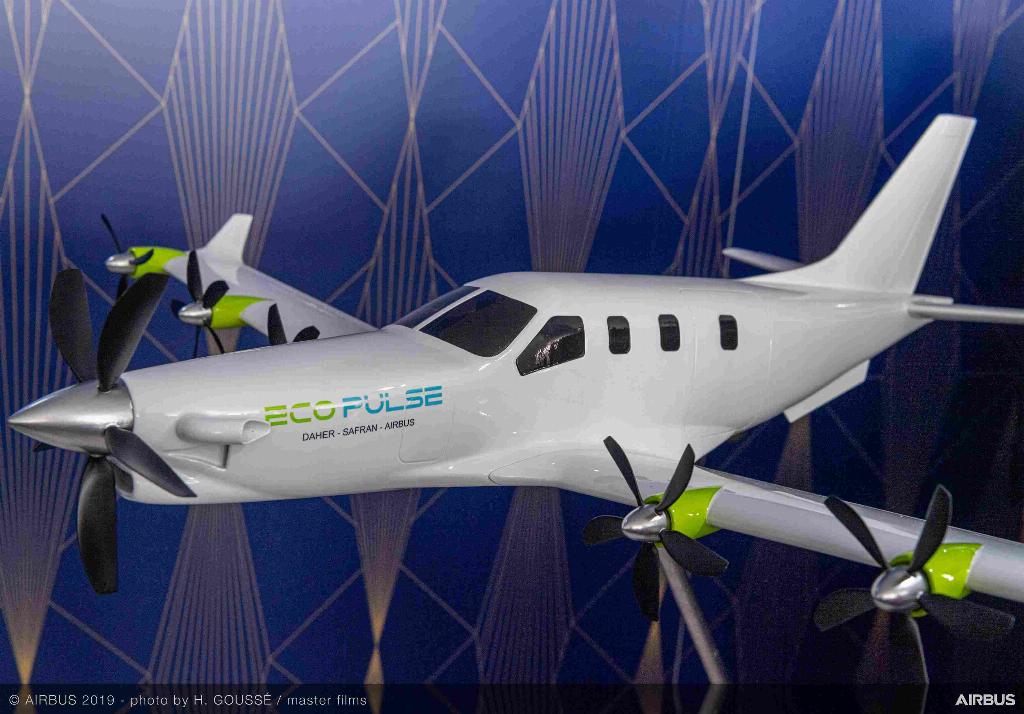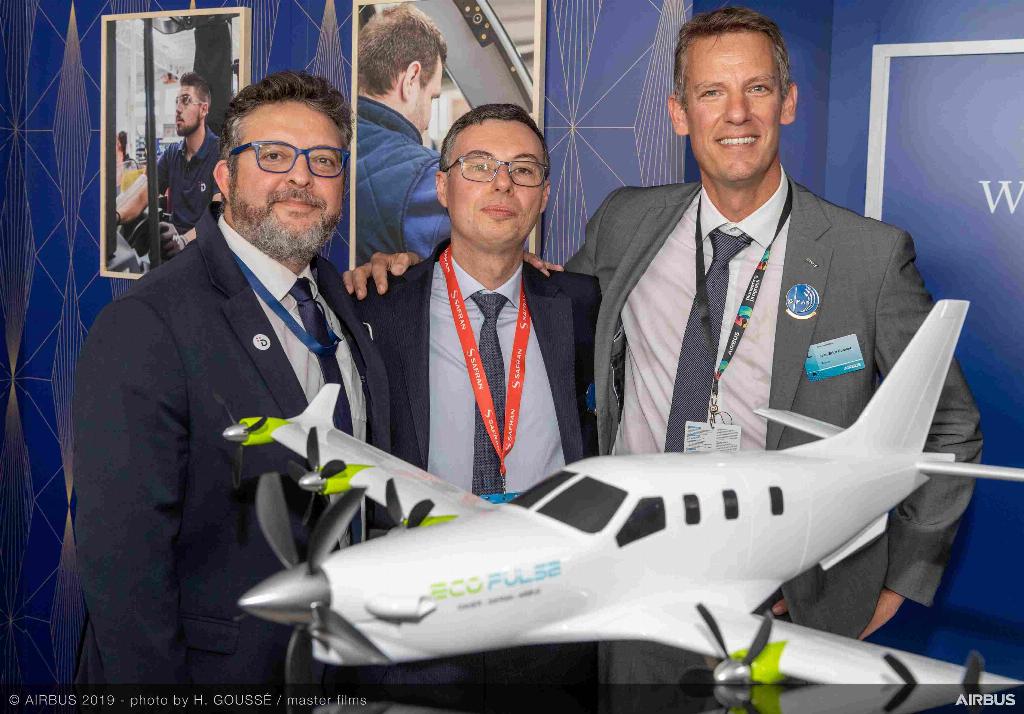An electric French revolution

Revealed at last year’s Paris Airshow, EcoPulse is an ambitious attempt to combine hybrid-electric power with distributed propulsion. Rob Coppinger looks at the challenge in bringing commercial electric distributed propulsion aircraft to the market.
In a surprise move in April, Airbus abandoned its three-year old E-Fan X hybrid-electric collaboration with Rolls-Royce, but it is still going ahead with its distributed propulsion project, EcoPulse. The project will develop and test a distributed electric propulsion system. This new type of propulsion is expected to reduce operating costs, carbon dioxide emissions and noise pollution for many types of aircraft.
An almost entirely French affair, EcoPulse involves France’s Civil Aviation Research Council, the country’s Civil Aviation Authority, its National Office of Space and Aerospace Research (ONERA), Airbus, and French firms, Safran and Daher, a turboprop business aircraft maker. When EcoPulse was jointly announced last June at the Paris Airshow, Daher's aerospace and defence senior vice-president, Nicolas Orance, said: “Reducing the environmental impact of aircraft is a concern for every part of the industry. We are determined to make it a distinctive feature of the French aircraft industry.”
EcoPulse will see flight tests using a piloted Daher TBM model turboprop and the maiden flight is scheduled for 2022. In comparison to the Daher TBM, which can carry six passengers, the abandoned E-Fan X project was to have used a 100 plus-seat BAe 146 regional jet to test hybrid electric power, but not a distributed propulsion system. In the joint announcement at the Paris Airshow, Airbus’ engineering executive vice-president, Jean-Brice Dumont, said: “This distributed hybrid propulsion demonstrator is a very important step towards preparing the certification standards for a more electric aircraft.” He used the word hybrid, as a hybrid power system will also be developed under EcoPulse.
Together in electric dreams
For the distributed propulsion system, the Daher TBM demonstrator will be modified with six electrically powered tractor propulsors along its wing. These propulsors will be provided by Safran whose goal is to become the market leader in this type of propulsion by 2025. The term propulsor describes a propeller, its motor and nacelle combined. Safran’s propeller is powered by its own EngineUS 50kW electrical, ‘smart motor’. Safran has developed its line of EngineUS motors for hybrid electric and all-electric platforms, from light jets to vertical take-off and landing (VTOL) craft and other urban mobility solutions.
Safran’s EngineUS range can be air cooled up to 100kW of power output with a power range that starts at 45kW and can drive propellers at 1,500rpm. The air cooling for the propulsors has been designed in partnership with French propeller manufacturer, DUC Hélices. The EngineUS motor’s power electronics are integrated into its housing. The hybrid power Dumont referred to and which feeds those EngineUS motors to individually turn those six propulsors comes from a turbine and a battery.

Of the six propulsors, the battery powers the two propulsors on the Daher demonstrator’s wing’s tips. They are there to cut the wing tip vortices to reduce drag and improve aerodynamic performance. The other four electric propulsors on the wing are powered by the turbine, made by Safran. Designed to be compact for an aircraft, the turbine is called a turbogenerator as it burns fuel to generate 100kW of electricity to power those four remaining propulsors.
Airbus will work with ONERA to simulate the propellers using computational fluid dynamics simulation. Such a simulation will also be used to predict the impact of the distributed propulsion on the TBM demonstrator itself. As well as simulations and actual flights, wind tunnel tests will be performed to predict the impact on the demonstrator by the distributed propulsion.
Another wind tunnel test campaign will be for a full-scale electric propulsor and this will be carried out at Airbus’ Filton wind tunnel facility in the fourth quarter of this year. The campaign’s main goal is to characterise the propulsors’ aerodynamics, loads, endurance and thermal management. Airbus is responsible for the aerodynamic optimisation of the distributed propulsion system, the high energy density batteries and the use of those batteries to power the aircraft.
Airbus’ Defence and Space division is developing the battery management system and housing design. This system uses commercial off-the-shelf components for the battery pack, and it will be, “compliant with high safety standards of the aviation industry,” according to Airbus. The batteries will be a high-density lithium design, but no further details were provided as they are, “still being refined as of today,” the European giant added.
We’ve got the power
While Airbus creates the battery management system, Daher is responsible for battery installation in the aircraft. For the electrical power system development, Airbus is using its experience in satellite batteries and its work in recent years on all-electric urban air mobility technology demonstrators, such as Vahana and CityAirbus. Daher will oversee the installation of the entire system, flight testing and it carries out the overall analysis.

Safran is providing the power management unit for the electrical system. The unit, designed to monitor power levels, uses new sensors and protection components, according to Safran, to stop high voltage failures. Other elements of the power system which are new technologies include, a controller that enables individual speed control of the six propellers and cables and their bundling which allows the high voltage wiring to more easily be enclosed within the propulsor.
Airbus and Daher have been digitally modelling the TBM demonstrator for its flight control laws. With such a radically different propulsion system, the demonstrator will need new flight control laws which have to be evaluated. Airbus’ simulation platform will integrate Daher’s TBM aircraft data and behaviour along with Safran’s propulsion system model and Airbus’ own aerodynamic and system modifications. “It also gives us the opportunity to improve our simulation models and consider their use on larger aircraft,” Dumont explained.
In the past, Airbus has released imagery of concept airliners using distributed propulsion systems. While EcoPulse’s 2022 maiden flight is using a small passenger aircraft, through this project, France’s aviation industry hopes to take leading roles in key technologies for what are expected to be more environmentally-friendly forms of flight, from electric VTOL to light jets. Bringing commercial electric distributed propulsion aircraft to the market could be as challenging as surmounting France’s highest peak, Mont Blanc, but its aerospace industry is now firmly at base camp.












